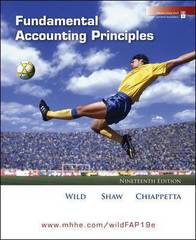Question
Motion Biotech Inc. (MBI), a Canadian company, was founded by Dr. James Clarkson six years ago. Clarkson has a PhD in organic chemistry and is
Motion Biotech Inc. (MBI), a Canadian company, was founded by Dr. James Clarkson six years ago. Clarkson has a PhD in organic chemistry and is guiding his team of scientists as they develop all-natural products to help deal with the damage caused by repetitive stress injuries. The demand for this type of product is expected to grow as baby boomers age and continue their active lifestyles.
Initially, all the capital came from Clarkson and government grants. Several venture capital funds became investors two years ago. As a result, 40% of the common shares are held by three venture capital funds, and Clarkson owns 60%. The venture capital investors are looking forward to a public offering of MBI shares, likely when the company has at least one more product in commercial development.
Biotech firms have significant hurdles to clear before a product can be commercially marketed. These products are subject to significant government regulation, in three phases. Phase I testing must establish product safety with animals. Phase II testing must establish product safety with humans, and Phase III clinical trials, the most expensive and risky, must establish that the product is effective for treating the condition for which it is designed. Fewer than 30% of Phase I compounds reach commercial production. The major risks are that the product will not be safe or effective; or that another treatment, a competitor product, will be developed that is more effective. However, once product approval is received, profit margins are very high- 80 to 90%.
MBI has two products in commercial production, one product in Phase III testing, and two products in Phase II testing. A number of other compounds are "in the lab" and are being considered for Phase I testing. The two products in commercial production have been modest successes, but not blockbusters.MBI hired a reputable marketing research company, which reported that there is significant demand for MBI's proposed products, that is, those still being developed. There is significant interest in the product now in Phase III testing, as the condition that it will treat is widespread.
You, an independent accountant, have been approached by one of the venture capital investors with a common share investment in MBI. The MBI balance sheet (draft copy) and some additional information have been provided to you (Exhibit). However, the income statement, cash flow statement, and disclosure notes are not available. You understand that MBI will report a loss of about $2.3 million this year, which is largely the result of expenditures of $2.1 million for the product in Phase III testing. Clarkson has described the loss as "a good thing, because it demonstrates our commitment to Phase III testing of a product with significant commercial potential." Clarkson is unhappy that these costs have not been deferred, as they represent a major investment in a future revenue-producing product.
The venture capital investor is interested in anyfinancial statement adjustmentsthat you feel are necessary. He would like to see the dollar amount (you may ignore tax), where possible, and rationale for any change you suggest to MBI's financial information.
Required:please respond to the requests of venture capital investor and address Clarkson's concerns in a report. Please limit your report to three pages, single-spaced with 12 point font. Be sure to enclose a revised copy of the balance sheet in an appendix, along with supporting detailed calculations and journal entries.
1.Investment in Star tech. MBI owns 20% of common shares, and accounts for it by using the cost method. Is this method of accounting appropriate? If not, what do you recommend and why (explain it in the report)? Based on your recommendation, you need to revise the balance sheet with supporting journal entries and calculations (reference
2. Non-monetary exchange of capital assets. Is the method of accounting used by the company appropriate? If not, repeat the steps in point 1 above (reference is in Ch 10)
3. Deprecation policy of leasehold improvements. Any recommendations and adjustments? (References are in Ch 10, 11)
4. Research and development cost of intangible assets. Again any recommendations and adjustments? (See ch 12 for references).
Notes:
1. MBI owns 20% of the common shares of Star Tech (ST) and accounts for its investment in ST using the cost method. The other 80% of ST's common shares are owned by other shareholders. ST has incurred losses of $220,000 since MBI purchased its investment early this year. ST's losses are due to its extensive research activities in dietary supplements designed to enhance bone density.
2. Deferred development costs relate to products in commercial production. All additional costs of development are deferred once Phase III approval is obtained. The costs are depreciated straight-line over 10 years.
3. The leasehold improvements were made three years ago and are being depreciated over the current lease term of five years plus the time of an estimated new lease of five years (total life of 10 years). MBI has not negotiated the new lease.
4. Equipment is depreciated on a straight-line basis over the useful life of five years with no residual value. New acquisition is at the half of the regular rate. On October 1, 2019, MBI transferred to Speedy Therapeutics Corp. (STC), certain equipment that MBI had carried on its books for $108,000. MBI accepted other laboratory equipment in exchange. This equipment had a net book value of $125,000 on STC's books. The equipment was appraised at $126,400, and MBI recorded a gain on the trade of $18,400.

Step by Step Solution
There are 3 Steps involved in it
Step: 1

Get Instant Access to Expert-Tailored Solutions
See step-by-step solutions with expert insights and AI powered tools for academic success
Step: 2

Step: 3

Ace Your Homework with AI
Get the answers you need in no time with our AI-driven, step-by-step assistance
Get Started


